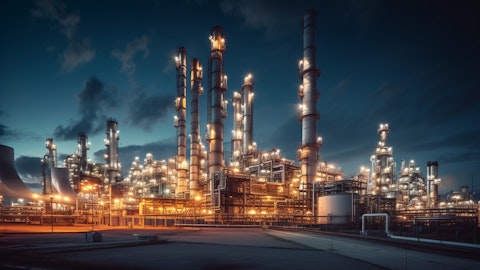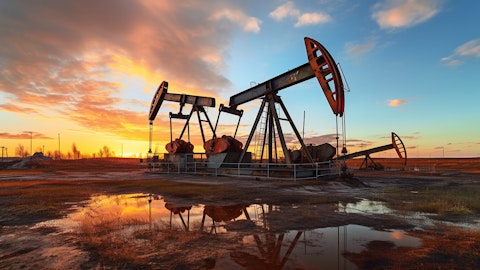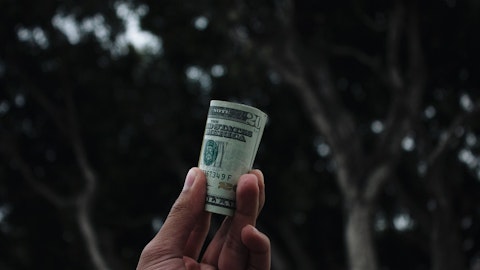And also about M&As, I think that several recent messages from the company and the Directors, they say that, yes, more inorganic investments will be made but that will not reinvolve the renationalization, as you said, of any asset. Is that still valid for investments under evaluation or is there any possibility of Petrobras having stakes higher than 50%? Thank you.
Jean Paul Prates: Well, I can answer the last question first, and then I’ll give the floor to you, Sergio. Concerning the rationalization, this is not only part of our vocabulary. We look at any of these assets as a business asset. If we need a majority to have control for strategic reasons, we will if not, we won’t. If it’s an asset that’s important for us, we’ll analyze it. If it’s not that important, if it’s part of the past and it’s not worth looking into it will not submit a proposal or approach it. So when I say that there will be no regionalization, it’s because there’s no reason for us to use this term. We’re not here to renationalize or bring something back to the state or re-privatize anything. In the case of Bahia, we’re talking to them because we got an invitation to combine the entire process that was ongoing and we thought it would be positive, so we’re analyzing it. So I just think that we have to rule out this old-fashioned terminology. Thank you.
Sergio Caetano Leite: Pedro, thanks for your question. And there is no indication and I believe that will remain like that for a while predicted for — to change the remuneration to investors. And what is behind the policy that we approved? There was a policy of 65% on the free cash flow in the past with several details that you’re familiar with but there was an important detail that was 65% less investments. But interestingly enough, it was not CapEx as we see in literature. If there was an acquisition, it would not be deducted from the 65%. On the other hand, it did not make clear which CapEx was under analysis. So now, in this more transparent process, we started to highlight the CapEx that’s under analysis, that there might be mergers in this amount.
On the other hand, we started to include CapEx as literature puts it, in terms of what’s deducted in the policy, and we reduced it to 45%. If you compare the two towers that indicate the use of sources, you’re going to clearly see a migration from close to 20% of the CapEx moving from dividends and going to investments. And why was that decision made? First, because the future is more challenging. Like President Jean Paul said, this is not considered a transition, but rather a transformation. And second because Petrobras wants to continue to generate profit and remuneration for the next 100 years. And thirdly, because Petrobras is a world-class company, and as proved, it will resume its internationalization process. So it made no sense for assets like Petrobras quality assets to pay such a different dividend than the majors.
So we looked at the majors, we checked the average. It was at 39%, 40%. And since this is a new administration, we decided to add a small risk premium. And we added to this reserve another practice, which is the purchase of shares. And with that, we are now leveling with the majors. So there is no reason for us to change the dividend policy. There is no indication that there’s any willingness to change that. The policy will be maintained. Leveraging has a direct connection with the policy, as you mentioned very well, Petrobras works between the BRL55 billion, BRL65 billion range. If there’s any change to the range, that requires a new policy and changes in the company. Now we’re close to BRL62 billion or BRL63 billion. At the end of five years, the leverage forecast is of around 57, lower than 59 considering the regular amortization and additional investments that we’re going to make over the course of the plan.
So, in addition to a robust balance and a commitment to capital management, so the maintenance of the leveraging level is one of the pillars of this administration. And not going over this level of leveraging is one of the prominent features of Petrobras right now. The M&As that you see in the PE consider that will maintain the indebtedness level. So right now, we don’t see any need to think about additional leveraging for an M&A. We are working with the idea of maintaining the range.
Pedro Soares: Okay, we cannot go over this range. What can we do within the — what’s outlined in the plan and not the other way around.
Sergio Caetano Leite: That’s very important. Maintaining the leveraging level capital management is almost like a mantra internally at Petrobras. So I’d like to pick it up on your question. I’d like to once again reiterate we’re looking at the chat, and there is an indication that there is still some confusion about the reserves. The reserve was created to balance out the payment of dividends, period. There is a possibility, which is provided for in law, any reserve has that possibility of being incorporated into the capital. But for that to happen, it requires certain triggers that are far from happening at Petrobras, and this needs to be decided by the high administration of the company. And there’s another possibility that’s equally remote.
If Petrobras has losses in 24 months, the possibilities of Petrobras to generate cash with its capital structure and considering how it manages its finance of generating loss in 2024 is a very small possibility. And these two cases are provided for in law, but they’re not even a remote possibility in any scenario that we’re working with. So this reserve is going to be allocated to dividends. The money that’s there is for the payment of dividends. The administration board looking at ’25, ’24, with our current strategic plan and with the appetite for investments, and with the plan of BRL0.5 trillion. If it’s not the biggest, it’s one of the biggest plans. It’s a clear bet in the future. So Petrobras will continue to grow for more than a century, whatever it sells in the future, electricity, liquid energy or if it will continue to sell oil, the future is going to show us.
But this reserve again is not to be used for investments or fiscal agreements. There is no indication that it will be incorporated into the capital. It is not going to be used to fill any gaps or losses. This is for the payment of dividends. And what I cannot tell you is the time frame it’s going to be paid like this or like that. The council is now analyzing this subject. It’s concerned with the global scenario in ’24 and ’25. That’s the highest management’s level of the company. Whenever they feel comfortable, they’re going to decide. And that can happen next week, next months, in 45 days, in six months. It may happen at any time, but unfortunately, today we have no indication of that.
Jean Paul Prates: But just to repeat, it will not be used for investments, for any deals, for M&As. This is in the plan. It’s to pay dividends. Thank you, Pedro.
Pedro Soares: Thank you, Sergio. That was very clear.
Operator: So the next question will be asked by Gabriel Barra from Citi. Go ahead, Gabriel.
Gabriel Barra: Hi, everyone. Good morning. Thank you for taking my questions. First, thank you for your initiative. This is going to make our discussion much better for the time that we have here after the results. We talked a lot about dividends and M&As, and I’d just like to ask about CIM again. I have a couple of points here. First, we’ve been seeing a challenging scenario in services. The company has been discussing discounts. We know how much inflation can impact the future. So I’d just like to understand how we can mitigate the risk? In the past, we saw some movements to capitalize assets, and I’m referring to building probes, building vessels. So considering future contracts and the company’s strong growth pipeline, I’d just like to understand what your strategy is, not only in probes and vessels, but also FPSOs and so on?
We’ve also heard a strong discussion about the strike in Ibama. We’ve talked about it Petroleo margin, how much it’s impacted the company, the future of the company and future value generation? So I’d just like to understand how that impacts the company currently, projects timeline for this year and for the next years? Is there anything that we should pay attention to on the short term? And my third question is, we saw relevant growth in the company’s production in the last years, especially led by the pre-salt layer and we’ve also heard an important discussion in Brazil about consolidating the industry. We see that the company is removing investments in the last years. So could there be contrary movement, maybe future acquisitions, not only in Brazil but abroad, and not only looking at organic growth, but also inorganic growth?
if that would be a part of the company’s growth strategy? That’s all. Thank you.
Sergio Caetano Leite: Thank you for your question, Gabriel. I think you addressed at least one to Travasso and a couple of them to Joel. So I’ll pass it over to Travassos, who is our Engineering Director at Petrobras.
Carlos Travassos: Thank you, Sergio. Thank you, Gabriel. Thanks for that question. So your perception is correct. We are looking at the supplier market, and we see an atypical movement from what we had in the last years. It was a movement that was much more aligned to bench prices, the prices of our inputs and equipment. In the last 18 to 24 months, we saw that it was disattaching itself to that, and it was a bit random. And of course, this is caused by the COVID pandemic and by the ongoing conflicts. You mentioned capitalizing assets. So to answer that clearly, that’s not on our radar. We’re not looking at capitalizing assets. What we are doing is a constant reading of the market. We’re establishing a system for each of these processes.
Building a collaboration room, where we’re going to, little by little, look at the market, understand its needs, and adjust our processes to ensure its competitiveness. So this doesn’t only happen in the FPSO market, we had a significant oscillation in the probes market. We’ve had over 50% of probes contracted, so we will possibly not have the same impact as we had in 2023. And similarly to that, we also see changing behaviors caused by the demand of Petrobras. We’re the biggest users of the marine system in the world, so we’re establishing a way of analyzing the market and adjusting our internal products, so that we can capture the market and reduce its impact. So I’ll pass it over to Joel, who will answer your next two questions.
Joelson Mendes: Thank you for the question. Yes, you’re right. It is concerning to see that Ibama strike. We renew many licenses every day. So besides that is, well, for example, license for waste material, for example. We don’t have a license for the third well, so it may have an impact. We also have licenses to drill some blocks in the Southeast of Brazil. That’s not our forecast, but we might need to change our portfolio. So it is concerning. We’ve been talking to Ibama consultants, but this is also in our risk analysis. So our exploration team, with the data it has, is trying to acquire more data from Latin America and West Africa, especially. So we have been talking to governments, to peer companies, and we’re also looking at opportunities to acquire producing assets as well.
It’s not very common, but it is a part of what we do. We have people who are always looking at that. So we might have more concrete studies to acquire exploration blocks and also to analyze production. So if we have a negotiation for that, we have a lot of governance, we have many steps. So going into a new country would require authorization by a board. So we have been working in that direction.
Operator: Thank you. And the next question will be from Vicente Falanga from Bradesco. Go ahead, Vicente.
Vicente Falanga: Thank you. Thank you, Jean Paul and Sergio. I have a couple of questions. I just like to understand if what was said in the board yesterday, if you added any metrics to what would be the drivers for you to pay the extraordinary, right, maybe gross increase or something like that? And I’d also like to know if this reserve has been used by Webex for the buyback program? So no metrics, just looking deeper into some analysis and we’ll just find that later on.
Sergio Caetano Leite: Thank you, Vicente. I haven’t seen you for some time. Good to hear from you. So buyback is considered, and then some pilot, we have some goals. We’re delivering monthly reports to CVM on how it’s doing. It’s at 80% or close to 80% execution, BRL157 million in preferential shares and we use a bank rotation system, so that we don’t get any criticism that we’re being discretionary. So we don’t — we’re always looking at daily operations, whenever we have an important event, like in this process, we suspend purchases and it’s been working very well. The difference, one of the biggest drivers of EBITDA, has reduced even if we count the cost of doing business in Brazil and exchange variations. This is another parameter that Petrobras may overcome in the future.
So we’re doing well. The buyback processes around the world have an average of 70% to 80%. So we can still complement it later on. We’ll see if we can take this forward. It is the intention of the company to continue with this program. So you can call Nardi, ask him. But we are preparing a new program to be proposed and to analyze it. This is an attribution of the Board to approve a proposal from our management. It’s a way of redistributing value for our investors as well. It’s a part of our remuneration policy. So it makes sense. Thank you.
Vicente Falanga: Thank you, Sergio. The last question will be asked by Rodrigo Almeida from Santander.
Rodrigo Almeida: Good afternoon. Can you hear me?
Jean Paul Prates: Yes, we can hear you.
Rodrigo Almeida: Thank you. I actually have a question and a follow-up. So we see net debt close to 73 billion. So considering the amount of rent values that will still come in, is there any liability that might require your cash to be above the reference value. So, looking at the plan, maybe the most CapEx heavy moment will be between 2024 and ’25, because of the number of platforms. So I’d just like to understand that it would be important to have that for the next quarters. So with the different spreads, it might help us to imagine that the valuation would be higher than before. So how is Petrobras working with the trial of accounts to justify it. Those are my questions. Thank you.
Jean Paul Prates: Thank you, Rodrigo, for your question. Starting with liability management, the peak in the debt was especially due to anticipating a receivable from 1R FPSOs. Usually, it would not reach 62. We would have amortization for it, and then that would create the curve. We presented a slide for the debt amortization process, even what we call the productive debt, that is a good debt from the rental. So it’s under control because it allows you to create a forecast for the oil curve. And that shows a reduction versus the beginning of that period. What I’m seeing here is that it’s under control. It’s under control. It’s close to 65, yes, but considering the receivables from FPSOs and the amortizations calendar, it’s going down and regressing according to our projections.
This was discussed. This was something that we analyzed. We looked at the different risk scenarios in finance’s impact to cash. So there are dozens if not hundreds of analyses that we run before we decide on that. But the curve is under control. And I understand your question, but it’s under control. Considering liability management, Petrobras has won awards and issued a global bond of 1.25 thousand dollars. And it used these resources for liability management. The difference in rates and other things, the spread of those rates and other things allow us to reduce the debt to a similar amount, 1.2 billion from a financial debt. It’s important to say that we got the lowest rate compressions in this operation and the highest rates for the period.
So we looked at our cash. We saw if we needed to do it and Petrobras was outside of the issuance market for number of years and we decided to test it. It was a very successful operation. We even received awards as the best in Latin America and one of the best in the world. So it really was an operation that we studied. The 1.25 billion was used for liability management. And whenever the market presents a favorable spread for VPL for Petrobras, Petrobras may go to the market for LP. There’s no need because our financial debt is very low. If you look at a company like ours, our debt is nearly negligible. The 0.8 that we present is less than one, and that’s much more related to our productive debt than a financial debt. So the answer is yes, we are looking at liability management, so that we can manage this.
Whenever the spread presents itself, we extend our debt. This is an ongoing process at Petrobras. So thank you for your question. We forgot to answer one of them on M&A processes. As Jean Paul said, there’s an example that we always use. If you are on a conveyer belt and you try to go back, even if you jump, you’re not going to go back to the same point. What we’re analyzing is the whole green fuel for aviation. There’s a growing demand for that. People who call us, who ask about biorefineries, this is a new horizon, right? We don’t need to buy 100%, but this is all being analyzed right now. But we’re not considering getting debt for this acquisition, as I explained before. So we were invited for an analysis. We are constantly in talks with others.
It’s a normal Petrobras process. It’s not light. It’s a heavy governance process. So it takes some time. Thank you.
Operator: Thank you, Sergio. This concludes our Q&A. If you have any additional questions, they can be sent to our Investor Relations team. We’ll be happy to answer them. I’ll now pass it over to Jean for his closing remarks.
Jean Paul Prates: Thank you. So I just have a very positive and upbeat note to say goodbye. This is something that we mentioned to our employees, but we want to highlight how good of a result this was. And we don’t want to be influenced by asset sales bonuses or refinery bonuses or anything else, as Brent is going down, as diesel cracking is going down. We are still achieving the second best results in our history in EBITDA, in operational cash flow, the highest profits among publicly-traded Brazilian companies, the third highest in global companies below Exxon and Shell, but above Chevron and Total, 13 operational records, gas processing, refining, logistics, patents engineering, reducing financial debt. I think we’re showing that despite going through challenges, this first year was extremely satisfactory and rewarding.
This is something that we’ve been trying to do. And I think any company like ours would need to do that. We need to do it every day. It’s not something special. This is our mission. Our mission is to match the interests of our stakeholders and we’ve clearly been able to do it. Our returns were the highest in the industry. We made rationality prevail by being insistent and by being respectful. So I’d like to ask you to stick around and to trust us. We’re doing serious, ethical, transparent work and we’re being efficient. We’re going to show you that for you who are investing in us, we’re trying to be a source of development and there’s only one way of making it consistent and perennial. It’s making that happen as often as we can. There might be some noise, but if we can do that, this is the winning formula for Petrobras and for any company that has our capital composition.
Thank you, everyone.
Operator: Thank you, Jean. Thank you everyone for listening to this webcast. Have a great day.




